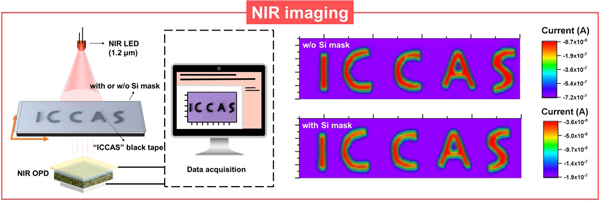Thanks to the advantages of tailorable optoelectronic properties, ease of processing, and compatibility with flexible substrates, solution-processed organic photodetectors (OPDs) with sensitive near-infrared (NIR) light response are promising to be employed in some emerging applications including wearable biometric monitoring, artificial retinal implants, biological/medical imaging, and others. However, very limited successful strategies have been reported to extend the photoresponse range of NIR OPDs to over 1.1 μm (the detection limit of widely-used silicon detectors) with high detectivity (D*). The key issue is the lack of high-performance organic photovoltaic materials with ultra-narrow bandgap, which can be mainly attributed to the limited electron-withdrawing capability of the existing terminal groups.
Recently, a joint research team led by Prof. LIN Yuze at the Institute of Chemistry, Chinese Academy of Sciences (ICCAS), Prof. SHEN Liang at Jilin University, and Prof. FANG Yanjun at Zhejiang University, reported a newly designed quinoid terminal group with high Mulliken electronegativity could construct small-molecule semiconductors with ultra-narrow bandgap and further acquire high detectivity below silicon bandgap. The study entitled “Sensitive photodetection below silicon bandgap using quinoid-capped organic semiconductors” was published in
Science Advances.
Researchers designed a new cyano-contained quinoid terminal group 2-(4-oxonaphthalen-1(4H)-ylidene)malononitrile (QC), which combined the reduction-induced aromatic stabilization of quinones and the strong electron-withdrawing property of cyano group. The resulted large Mulliken electronegativity of QC (5.62 eV) is notably higher than those of other widely-used terminal groups (4.61-5.46 eV). The QC-based small-molecule semiconductors show optical bandgaps (Egopt) as small as 0.77 eV, 0.40-0.45 eV narrower than their 1,1-dicyanomethylene-3-indanone-based counterparts. The photodiode-type NIR OPDs exhibit high D* values over 1012 Jones in a wide photoresponse region of 0.41-1.2 μm with a maximum D* of 2.9 × 1012 Jones at 1.02 μm. The high D* values in 0.9-1.2 μm are on par with those of commercial InGaAs photodetectors, despite the detection limit of the NIR OPDs being shorter than InGaAs (~1.7 μm). The practical application potential is demonstrated well by the spectrometer prototype with a wide measurable spectral region of 0.4-1.25 μm and the NIR imaging of the letters “ICCAS” under illumination of 1.2 μm-wavelength light. This work provides an efficient molecular design strategy to construct ultra-narrow bandgap semiconductors with high NIR light sensitivity and will promote the development of other applications of NIR-sensitive organic semiconductors, such as transparent solar cells, photoacoustic imaging, and photothermal therapy.
This work was financially supported by the National Natural Science Foundation of China and the China Postdoctoral Science Foundation etc.
Imaging of “ICCAS” letter graphics without (top right) and with (bottom right) Si mask under 1.2 μm LED illumination (Image by Prof. LIN Yuze)
Contact:
Prof. LIN Yuze






